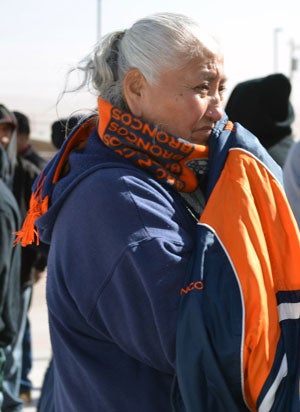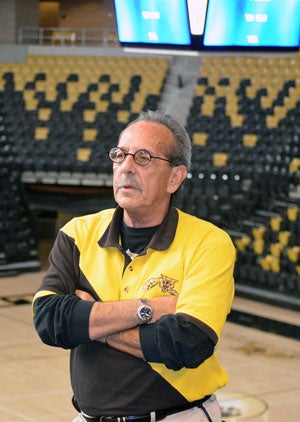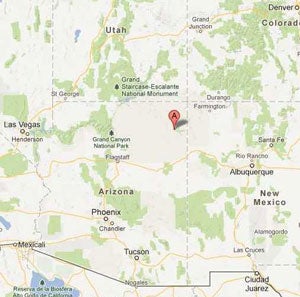
Life in the Navajo Nation is something most Americans will never get to see. While many would spout off cities like New York, Los Angeles, Indianapolis and other big places when it comes to the most basketball-crazed communities, this off-the-beaten-path part of the southwest features a fervor for hoops that is unmatched across the 50 states. Need evidence? Check out Rez Ball.
Video screenshot
— Richard Obert, "Rez Ball"
CHINLE, Ariz. — It was four hours before tip-off. The wind whipped sharply and briskly from the north and dust swirled in every direction. Temperatures dropped into the 30s. Snow fell by the evening.
Hundreds of American Indians were bundled in bright colored wool jackets and blankets — blue and red, yellow and green — outside the Wildcat Den's ticket booth on the campus of
Chinle High School.
The windows didn't open for another three hours.
There wasn't much chatter. No loud horns, banter or school fight songs. There was no complaining either, and no tailgating. Just standing and waiting. Waiting and standing. It's part of the ritual, like eagle feathers for protection in player lockers or blending corn pollen into water for harmony.
This was Rez Ball on game day, and patience, loyalty and love for the game prevailed.

A woman waits to get into the Wildcat Den in Chinle,Ariz., on Feb. 8. Locals will sit outside gymnasiumsfor hours - even overnight - just to get a chance attickets close to the floor. In a part of the country thatlacks many of the entertainment options urbanitesenjoy, Rez Ball is the hot ticket.
Photo by Geri Henry
Eight high school basketball teams — four boys and four girls — faced off in a non-elimination Arizona Interscholastic Association sectional finals Feb. 8-9, and fans arrived from across the Navajo Reservation, the largest Indian reservation in the United States at more than 24,000 square miles, running through northeastern Arizona and parts of New Mexico and Utah.
They weren't early just to get a seat. They wanted
good seats.
"I heard the lines get to be about a mile long," said 63-year-old Vic Welker, a longtime rodeo fan making his first trip to the Den from White Mountain, Ariz. He's not even a huge basketball backer, but wanted to show his support for
Alchesay (Whiteriver), which boasted a boys and girls team in the Final sectional 4.
"It's about a 4.5-hour drive. I left before 7."
That was two hours after Matthias Lupe arrived. He left Whiteriver at 1 a.m. He wanted to be the first in line.
"They call me the No. 1 fan of Alchesay," said Lupe, a 2004 graduate of the school. "I like to be at the bottom, right on the court so I can scream my head off. … Once you get in there, it's a big rush. You can't really explain it. Your friends and family and community is all in there. It's an unexplained feeling."
American Indians have tried to explain their love of the game for decades, all the way back to James Naismith and the 1890s.
A combination of its speed and teamwork in an organized setting, combined with the ability to practice alone endlessly at little to no cost makes it a natural sport for kids who reside in two of the most impoverished counties in America: Apache and Navajo.

Chinle High basketball coach and athletic directorSteve Troglia says Rez Ball is a diversion for manyin the Navajo Nation.
Photo by Geri Henry
Makeshift hoops made from bicycle rims and milk crates, nailed to trees and sides of homes and other dwellings, are everywhere on the vast and open landscape. So is a keen sense of history and pride, community and hope.
Basketball, especially the high school brand, is a great escape.
"For two or four hours, you're able to forget everything and just cheer and holler," Chinle athletic director and basketball coach Steve Troglia said. "Everybody in the (Navajo) Nation comes out to watch it and experience it. They want to be a part of it."
Said
Window Rock (Fort Defiance) four-year senior point guard
Kyler Ashley: "To play in front of a big crowd just feels like freedom. Your fans are always following you. They travel from hours away just to watch you play. They have a lot of heart. They stand in line early in the morning. They even camp out. How can you not like that? We play for our community."
Winslow girls sophomore guard
Shandiin Armao said basketball is just part of the Navajo culture. Their parents and grandparents played.
"Everyone plays basketball on the reservation," she said. "Even if you're not on a team. Kids will say, ‘Hey, you want to go shoot around after school?'"
Arizona Republic staff writer Richard Obert has covered prep basketball on the reservation for almost 15 years. Its popularity and passion, combined with the culture, inspired him to write a yet-to-be-published book, entitled "Rez Ball."
"People just go nuts for it," he said. "They can't get enough of it. The kids are treated like rock stars. You'll see little kids line up before games and after games trying to get these guys' autographs.
"They feel like the Kobe Bryants and Lebron James' of the world when they're on the reservation."

Chinle is located in the Four Corners region.
Screenshot
Troglia simply put it this way:
"There's no place like Chinle or reservation basketball," he said. "This is the Mecca of basketball."
He didn't mean the Mecca of the Four Corners region, or the state of Arizona. He meant anywhere.
He considered the heart of New York City, the tough streets of Detroit and the rural regions of Indiana. He considered that the Wildcat Den holds 7,000 in a town of 5,200 residents and that over the next two days, without either Chinle team participating, more than 12,000 attended the sectional.
Chinle and arch-rival Window Rock, a 90-minute drive away, always draw standing-room crowds of 7,500. The rest of the Rez schools aren't far behind.
To accommodate high demands,
Monument Valley (Kayenta) (5,000),
Ganado (5,500),
Tuba City (4,500), Winslow (3,500) and Alchesay (3,000) all fill their large venues.
Window Rock is moving from its famed Thunderdome that seats 1,800 to a new facility that will hold between 8,000 and 10,000.
"If they build it, the Nation will come," Troglia said.
They also travel. Remarkably so.
Every AIA basketball attendance record near and around Phoenix — a five-hour drive from the reservation — is tied to a Navajo Nation participant. Multiple games have drawn more than 16,000 when two Rez teams are involved for the state title — boys or girls.
"It's a lot like Mardi Gras," said Charles Gover, a former Tuba City boys coach, the last one to lead a Rez boys team to a state title in 2001. "Families plan vacations around the state tournament."
That's music to the ears of AIA Director of Business Media Brian Bolitho.
"The reservation schools have a great following," he said. "To see the crowds that follow their teams at NAU (Northern Arizona University), Tim's Toyota Center and when any team reaches Jobing.com Arena is something to see."
That is why the state's prime time game — the last of the eight on Saturday at Jobing.com Arena (home of the Phoenix Coyotes) — is the Division III girls championship, a game dominated by Rez teams.
See the MaxPreps AIA girls basketball playoff brackets
Around 10,000 people watched the Page High girlswin the AIA Division III state title last season bybeating Winslow, another team that hails from Navajocountry. The land for Page, Ariz., was acquired fromthe Navajo Nation.
File photo by Todd Shurtleff
In most states, that's a natural spot for a large-division boys game.
This season is no exception, as the final four Division III girls teams are Winslow versus
Holbrook and
Window Rock against
Valley (Sanders).
Last season, more than 10,000 watched
Page, another reservation team, defeat Winslow in the finals. Division III is the second-smallest division in the state, but the Navajo Nation has proved for decades that it packs a tremendous percentage of fans.
And they make a tremendous amount of noise.
Said Troglia: "I've been in timeouts during a Rez Ball game that it's so loud I can't even think, let alone talk."
Which is in sharp contrast to a culture known for its tranquil and quiet ways.
"Everything is very, very slow on the reservation, but everything is very, very fast on the court," Obert said. "And when they get going it's a totally different type of basketball. You won't see anything else like it in the country. The fans, the passion, the pace. It's like nowhere else."
Video and editing by Scott Hargrove
